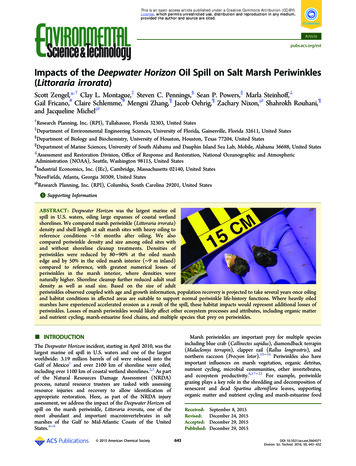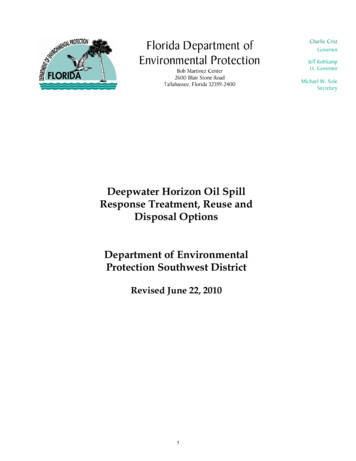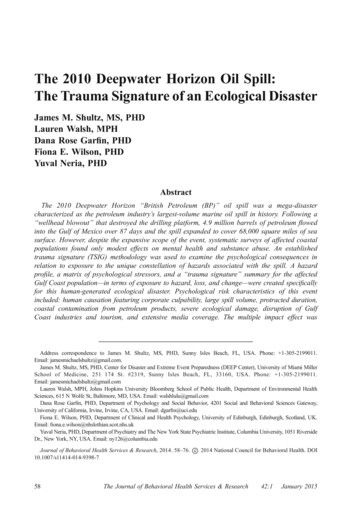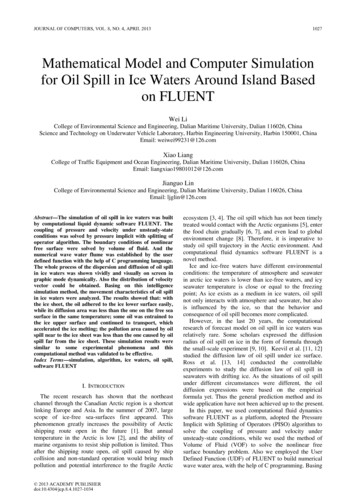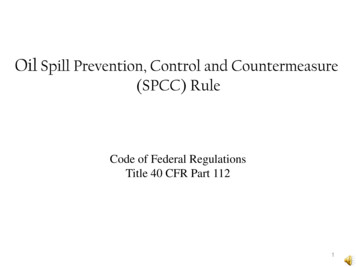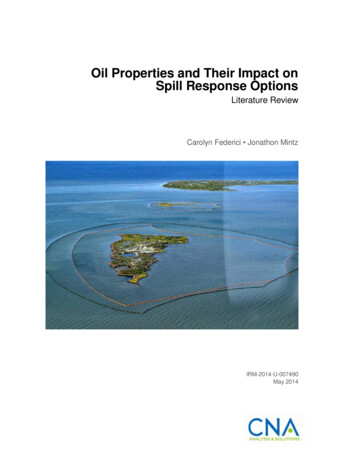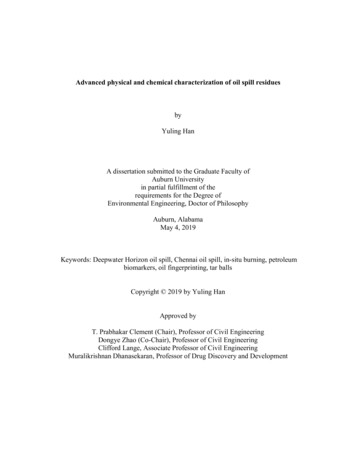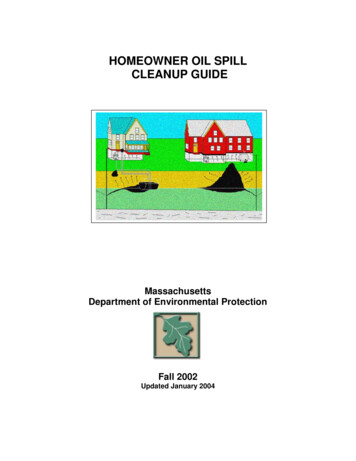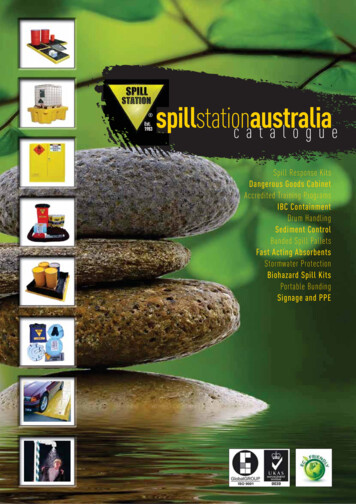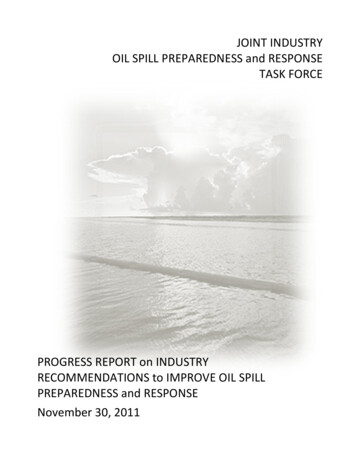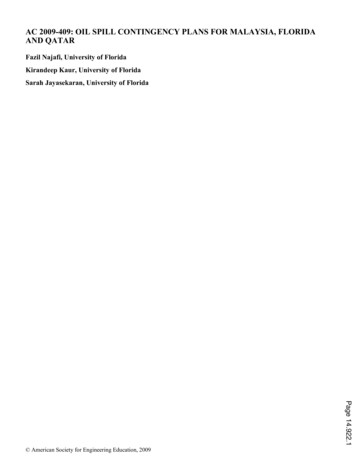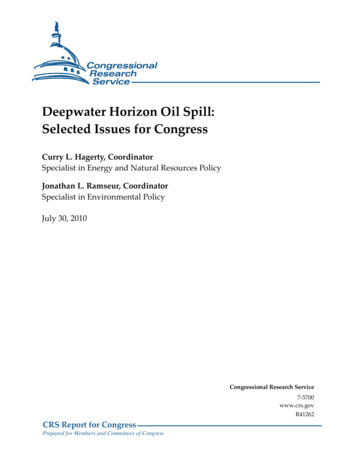
Transcription
Deepwater Horizon Oil Spill:Selected Issues for CongressCurry L. Hagerty, CoordinatorSpecialist in Energy and Natural Resources PolicyJonathan L. Ramseur, CoordinatorSpecialist in Environmental PolicyJuly 30, 2010Congressional Research Service7-5700www.crs.govR41262CRS Report for CongressPrepared for Members and Committees of Congress
Deepwater Horizon Oil Spill: Selected Issues for CongressSummaryOn April 20, 2010, an explosion and fire occurred on the Deepwater Horizon drilling rig in theGulf of Mexico. This resulted in 11 worker fatalities, a massive oil release, and a nationalresponse effort in the Gulf of Mexico region by the federal and state governments as well as BP.Based on estimates from the Flow Rate Technical Group, which is led by the U.S. GeologicalSurvey, the 2010 Gulf spill is the largest oil spill in U.S. waters. The oil spill has damaged naturalresources and has had regional economic impacts. In addition, questions have been raised as towhether offshore regulation of oil exploration has kept pace with the increasingly complextechnologies needed to explore and develop deeper waters.Crude oil has been washing into marshes and estuaries and onto beaches in Louisiana,Mississippi, and Alabama. Oil has killed wildlife, and efforts are underway to save oil-coatedbirds. The most immediate economic impact of the oil spill has been on the Gulf fishing industry:commercial and recreational fishing have faced extensive prohibitions within the federal watersof the Gulf exclusive economic zone. The fishing industry, including seafood processing andrelated wholesale and retail businesses, supports over 200,000 jobs with related economic activityof 5.5 billion. Other immediate economic impacts include a decline in tourism. On the otherhand, jobs related to cleanup activities could mitigate some of the losses in the fishing andtourism industry.The Bureau of Ocean Energy Management, Regulation, and Enforcement (BOEMRE), formerlyknown as the Minerals Management Service (MMS), and the U.S. Coast Guard are the primaryregulators of drilling activity. The Coast Guard generally overseas the safety of systems at theplatform level of a mobile offshore drilling unit. The Environmental Protection Agency (EPA) hasmultiple responsibilities, with a representative serving as the vice-chair of the National ResponseTeam and Regional Response Teams. The Federal Emergency Management Administration(FEMA) has responsibilities with respect to the economic impacts of the spill; its role so far hasbeen primarily that of an observer, but that may change once the scope of impacts can be betterunderstood.BOEMRE/MMS is also the lead regulatory authority for offshore oil and gas leasing, includingcollection of royalty payments. Its regulations generally require that a company with leasingobligations demonstrate that proposed oil and gas activity conforms to federal laws andregulations, is safe, prevents waste, does not unreasonably interfere with other uses of the outercontinental shelf, and does not cause impermissible harm or damage to the human, marine, orcoastal environments. Further attention to the internal organization of BOEMRE/MMS is anongoing legislative and regulatory focus.Several issues are developing for Congress as a result of the Deepwater Horizon incident.Questions include: What lessons should be drawn from the incident? What technological andregulatory changes may be needed to meet risks peculiar to drilling in deeper water? How shouldCongress distribute costs associated with a catastrophic oil spill? What interventions may benecessary to ensure recovery of Gulf resources and amenities? What does the Deepwater Horizonincident imply for national energy policy, and the trade-offs between energy needs, risks ofdeepwater drilling, and protection of natural resources and amenities? This report provides anoverview of selected issues related to the Deepwater Horizon incident and is not intended to becomprehensive. It will be updated to reflect emerging issues.Congressional Research Service
Deepwater Horizon Oil Spill: Selected Issues for CongressContentsIntroduction .1Setting: Oil and Gas Recovery in the Gulf of Mexico .2Offshore Oil and Gas Drilling Technology.2Methane Hydrates in the Gulf of Mexico.4Weather and Ocean Currents in the Gulf of Mexico .5Biological Resources of the Gulf of Mexico .6Federal Statutory Framework .6OCS Leasing.7Oil Spill Response .7National Contingency Plan.8Role of the Secretary of Homeland Security .9National Response Framework.9Oil Spill Liability . 10Limits (or Caps) to Liability. 11Loss of Liability Limit . 11Oil Spill Liability Trust Fund . 12OPA Compensation and Claims Process . 12Federal Regulatory Framework . 13Bureau of Ocean Energy Management, Regulation, and Enforcement (BOEMRE,Formerly MMS). 14Wells. 15Platforms . 15Equipment and Facilities . 16Role of U.S. Coast Guard. 16The International Maritime Organization (IMO). 17Classification Societies . 17Oil Spill Response Issues . 18Use of Dispersants . 18Louisiana Protective Berm Project . 20Relief Wells . 22What Are Relief Wells? . 22Examples of Relief Wells Being Used to Stop Blowouts. 23Relief Well Policies. 24Issues for Further Consideration. 25Response Vessels and the Jones Act. 27Investigations and Commissions . 27Environmental and Economic Impacts . 28Environmental Impacts . 28Natural Resource Damage Assessment and Compensation. 29Environmental Recovery. 30Economic Impacts. 30Natural Resources and Related Economic Activity . 30Impact on Oil and Natural Gas Prices . 32Possible Impacts on Shipping. 34Labor Issues. 34Congressional Research Service
Deepwater Horizon Oil Spill: Selected Issues for CongressSafety and Health of OCS Workers. 34Oil and Gas Industry Safety Statistics. 35Coast Guard Oversight of OCS Safety. 37Technical Competence . 37Regulatory Issues . 37IMO Convention Issues. 38Reorganization of BOEMRE/MMS. 39Establishment of the Minerals Management Service. 40Administrative Reorganization by Secretary Salazar. 41Call for Organic Legislation . 43Agency Reorganization Legislation During the 111th Congress . 43FEMA Issues . 45Federal Duplication/Federal Coordination . 45Exxon Valdez. 46Recent Regional Disaster History. 47Conclusion. 47FiguresFigure 1. The Loop Current .6Figure 2. Cumulative Dispersant Application in Gulf Oil Spill. 20Figure 3. Image of Two Relief Wells Being Drilled by BP to Plug the Deepwater HorizonWell . 23Figure 4. Gulf of Mexico Fishery Closure . 31ContactsAuthor Contact Information . 49Congressional Research Service
Deepwater Horizon Oil Spill: Selected Issues for CongressIntroductionOn April 20, 2010, the Deepwater Horizon oil drilling rig—under contract to BP, the leaseholderof the tract approximately 50 miles offshore of Louisiana—was nearing completion of adeepwater oil well when an explosion occurred. An apparent equipment failure, perhaps of theblowout protector, at the wellhead released oil and natural gas; explosions and fire on the oil rigkilled 11 of the crew, and the rig sank within days. In the aftermath, the oil spill became thelargest in U.S. waters. Based on estimates from the Flow Rate Technical Group, which is led bythe U.S. Geological Survey, it appears this oil spill would eclipse the 1989 Exxon Valdez spillseveral times over.1 Crude oil has been washing into estuaries and onto beaches in Louisiana,Mississippi, and Alabama; affected fishing and shrimping areas in the Gulf of Mexico have beenclosed.The former Minerals Management Service (MMS), now known as the Bureau of Ocean EnergyManagement, Regulation, and Enforcement (BOEMRE), in the Department of the Interior (DOI)is responsible for leasing the tract to BP.2 (Because the name change is relatively recent, hereafterin this report this agency will be referred to as BOEMRE/MMS.) The U.S. Coast Guard overseesthe fitness of the rig and efforts to control the leak. The Environmental Protection Agency (EPA)has multiple responsibilities, with a representative serving as the vice-chair of the NationalResponse Team and Regional Response Teams. The Federal Emergency ManagementAdministration (FEMA) has responsibilities with respect to the economic impacts of the spill; itsrole so far has been primarily that of an observer, but that may change once the scope of impactscan be better understood. Information about the Deepwater Horizon rig, its drilling operations,and the federal response to the oil spill is available from numerous sources, includingBOEMRE/MMS and the Coast Guard, the two agencies with lead federal roles in governingresponse efforts. As the lessee of the area in which the offshore facility is located, BP isresponsible for capping the leak and paying for removal costs.Issues such as worker safety, economic and environmental impacts, and oil and gas leasing forexploration and development are the focus of congressional attention at this time. The incidenthas triggered numerous congressional hearings, including those investigating the causes of theblowout; impacts of the spill; liability for damages; and the administrative process of leasing andregulatory requirements concerning health, safety, and environmental protection in drilling.Secretary Ken Salazar of DOI initiated changes in the administration of offshore oil drilling bysplitting MMS functions into three new bureaus, one to conduct leasing, one to enforce safety andenvironmental requirements, and one to handle revenues. Congress will be evaluating thisreorganization and examining the adequacy and effectiveness of statutes governing leasing andoil spills, including the Outer Continental Shelf Lands Act of 1953, as amended (OCSLA), andthe Oil Pollution Act of 1990 (OPA).This report provides an initial overview of Deepwater Horizon-related issues for Congress, andrefers readers to in-depth CRS reports on specific issues. Congressional readers with questions1For up-to-date estimates of the spill rate, see the most recent press releases from the Department of the Interior, athttp://www.doi.gov/news/index.cfm/.2Secretarial Order 3302, issued June 18, 2010, changed the name of the Minerals Management Service to the Bureauof Ocean Energy Management, Regulation, and Enforcement (BOEMRE). The name change was effectiveimmediately.Congressional Research Service1
Deepwater Horizon Oil Spill: Selected Issues for Congressabout an issue discussed in this report should contact the experts listed in CRS Report R40883,Oil Spill in the Gulf of Mexico: CRS Experts.Setting: Oil and Gas Recovery in the Gulf of MexicoSediments buried deep below the seafloor in the Gulf of Mexico host large quantities of oil andgas that have been the target of exploration activities for decades. Most of the undiscovered oiland gas on the U.S. outer continental shelf (OCS) is thought to occur in the Gulf, particularly inthe central and western regions. The central and western Gulf account for about 48% of theundiscovered technically recoverable resource (UTRR)3 for oil and about 50% of the UTRR fornatural gas in the entire U.S. OCS, according to the Department of the Interior.4 (In comparison,Alaska accounts for about 31% of the UTRR for oil and gas in the OCS.)Recent attention has focused on oil and gas resources underlying deep water in the Gulf (i.e.,deeper than 1,000 feet), because that is where the largest resource potential exists and where themajority of OCS leases are held. 5 Since 2006, there has been a 44% increase in proven deepwaterdiscoveries in the Gulf, even though most of the deepwater leases are as yet undrilled. (Forexample, 272 of nearly 1,900 ultra-deepwater leases—those at a water depth greater than 5,000feet—were drilled between 1996 and 2007.) Deepwater and ultra-deepwater exploration anddevelopment have been the focus of OCS oil and gas development in recent years, and thepotential for new and large discoveries in that part of the Gulf has been viewed as key to slowingor stopping the decline in OCS oil and gas reserves. (For a more complete discussion of OCS oiland gas issues, see CRS Report R40645, U.S. Offshore Oil and Gas Resources: Prospects andProcesses, by Marc Humphries, Robert Pirog, and Gene Whitney.)Offshore Oil and Gas Drilling Technology6In comparison with nearshore oil and gas activities, deepwater and ultra-deepwater explorationand production require technologies that can withstand high pressures and low temperatures at theseafloor, and require the operator to control the process remotely from a surface vessel thousandsof feet above the actual well. Seawater temperatures are lower in these waters (for example, at5,000 feet deep in the Gulf, the seafloor water temperature is about 40o F, or 4.4o C); andpressures are greater (at 5,000 feet deep the seafloor pressure is about 2,500 psi). Consequently,equipment and operations at the seafloor are accessible only by remotely operated vehicles(ROVs). Drilling technologies built to withstand the harsher conditions in deep water and ultradeep water are complicated, difficult to repair, and expensive. In addition, long lengths of pipe, ormarine “riser,” extending from the seafloor to the drill rig, are needed, requiring a large andcomplex surface platform to conduct operations through the longer pipe. One of the mostcommon types of drilling platforms for deep water and ultra-deep water is a semisubmersible rig,3The undiscovered technically recoverable resource (UTRR) is an estimate of the volume of oil or natural gas that islikely to be recovered using currently available technologies without considering price. UTRR changes as availabletechnology changes, but not as price changes.4Statement of Steven C. Allred, DOI/MMS, January 25, 2007.5Thirty-five percent of active OCS leases are in water depths of less than 200 meters, while 51% of active OCS leasesare in water depths of 1,000 meters and deeper.6Prepared by Peter Folger, Specialist in Energy and Natural Resources Policy.Congressional Research Service2
Deepwater Horizon Oil Spill: Selected Issues for Congresswhich has an upper and lower hull. During the drilling operation, the lower hull is filled withwater, partially submerging the rig but leaving the upper hull floating above the drill site. 7Transocean’s Deepwater Horizon rig was a semisubmersible platform, kept in place above thedrill site by a dynamic positioning system (i.e., not permanently anchored to the seafloor) andconnected to the well by the marine riser.8During drilling operations, the drill bit and drill pipe (or drill string) extend through the riser fromthe drill platform and through a subsea drilling template—essentially a large metal box embeddedin the seafloor—into the marine sediments and rocks down to the hydrocarbon-bearing zone. Aspecial fluid called drilling mud (a mixture of water, clay, barite, and other materials) is circulateddown to the drill bit and back up to the drilling platform. The drilling mud, which has higherviscosity and density than water, serves several purposes: it lubricates the drill bit, helps conveyrock cuttings from the drill bit back to the surface, and exerts a column of weight down the holeto control pressure against a possible blowout. A blowout can occur if the subterranean pressureencountered down the hole exceeds the pressure exerted by the weight of the drill assembly anddrilling mud. The Deepwater Horizon rig experienced a blowout on April 20, 2010, and the roleof the drilling fluid is under investigation.Drilling a deepwater or ultra-deepwater well is a multi-step process. At different stages the drillstring is removed and steel casing is inserted into the wellbore, telescoping down from thelargest-diameter casing at the top of the well to the smallest diameter at the bottom. Casingserves, among other things, to stabilize the wellbore, prevent the formation from caving in,maintain control of fluid pressure, and prevent crossflow of fluids from one part of the formationto another. The bottommost interval of casing, usually called the production casing, is insertedthrough the interval in the formation containing hydrocarbons that the operator wishes to produce.The casing is cemented in place over various intervals; cement is injected between the well casingand the surrounding rock. In addition, cement may be injected into intervals of the casing itselfwhen the well is to be temporarily or permanently plugged. 9 At the Deepwater Horizon well,Halliburton (as a contractor for BP) had finished cementing the final production casing stringabout 20 hours before the blowout on April 20, according to congressional testimony. 10As a last line of defense against a blowout, a blowout preventer (BOP) is installed at the seafloorand connected to the marine riser. The BOP is essentially a system of valves designed to be closedin the event of anomalous wellbore pressure (such pressure is sometimes referred to as a “kick”).At the depth and pressures encountered by the Deepwater Horizon well, BOEMRE/MMSregulations require at least four such valves, or rams, which must be remote-controlled andhydraulically operated during offshore operations.11 During the Deepwater Horizon blowout, allof the rams on the BOP failed to close properly.7For a more detailed description of drilling rigs, see http://www.naturalgas.org/naturalgas/extraction offshore.asp.For specifications about the Deepwater Horizon, see 56C17.html?LayoutID 17.9For example, in the Deepwater Horizon well, casing intervals spanned nine different diameters, from 36-inchdiameter casing at the top of the well, to 7-inch diameter casing at the bottom, according to congressional testimony.Also, the witness stated that there was no continuous cement column throughout the entire wellbore. Testimony by TimProbert, President, Global Business Lines and Chief Health, Safety, and Environmental Officer, Halliburton, hearing toreview current issues related to offshore oil and gas development, U.S. Congress, Senate Committee on Energy andNatural Resources, 111th Cong., 2nd sess., May 11, 2010.10Testimony by Tim Probert, Halliburton, May 11, 2010.1130 C.F.R. § 250.442.8Congressional Research Service3
Deepwater Horizon Oil Spill: Selected Issues for CongressBOPs can have backup systems that would attempt to engage the rams in case of loss of directcommunication to the drilling vessel at the surface. One type of backup system, referred to as a“deadman switch,” is intended to operate automatically if communication to the surface isdisrupted. A second type of backup system, referred to as an “autoshear,” would automaticallyactivate one of the rams if the lower marine riser pipe disconnected. Another form of backupsystem includes the use of remotely operated vehicles (ROVs), controlled from the surface, whichcan operate control panels on the BOP itself at the seafloor. In the Deepwater Horizon incident,the BOP was reportedly equipped with a deadman switch12 and an autoshear device, and ROVswere used to attempt to activate the BOP after the blowout occurred. These systems appear tohave failed to fully engage the BOP.Methane Hydrates in the Gulf of Mexico13At the temperatures and pressures of deepwater and ultra-deepwater drilling in the Gulf ofMexico, solid methane hydrates can occur. They constitute a potential natural gas resource as wellas a possible risk to exploration activities. In a methane hydrate, frozen water molecules form acage-like structure around molecules of methane, the primary component of natural gas. In 2007,BOEMRE/MMS released an estimate of methane hydrate resources in the Gulf with a mean valueof 21,000 trillion cubic feet, although the report noted that the amount of hydrate commerciallyrecoverable using current technology is likely just a fraction of that resource. 14 Methane hydratesalso present a significant hazard for drilling and production operations.15 Offshore drillingoperations that disturb methane hydrate-bearing sediments could fracture or disrupt the bottomsediments and compromise the wellbore, pipelines, rig supports, and other equipment involved inoil and gas production from the seafloor.16 Decreases in pressure and/or increases in temperaturecan cause a solid methane hydrate to dissociate and rapidly release large amounts of gas into thewellbore during a drilling operation. (For a more detailed discussion of methane hydrates, seeCRS Report RS22990, Gas Hydrates: Resource and Hazard, by Peter Folger.)Methane hydrates also have interfered with attempts to divert oil and gas from the DeepwaterHorizon blowout. When BP first attempted to lower a steel “cofferdam” over the leaking riserpipe to intercept the oil and gas and divert it to the surface, methane hydrates formed and cloggedvalves and piping leading to the surface. This occurred because methane gas from the wellboreencountered cold seawater at 5,000 feet below the ocean surface, and methane converted from agas to solid methane hydrate. Methane hydrates are stable at that depth and temperature.12According to testimony by Steve Newman, President and CEO of Transocean Ltd., in response to questions duringthe House Committee on Energy and Commerce, Subcommittee on Oversight and Investigations, Inquiry Into theDeepwater Horizon Gulf Coast Oil Spill, hearing, 111th Cong., May 12, 2010.13Prepared by Peter Folger, Specialist in Energy and Natural Resources Policy.14U.S. Department of the Interior, Minerals Management Service, Resource Evaluation Division, “PreliminaryEvaluation of In-Place Gas Hydrate Resources: Gulf of Mexico Outer Continental Shelf,” OCS Report MMS 2008-004(February 1, 2008), at 8-004.pdf.15Timothy S. Collett and Scott R. Dallimore, “Detailed Analysis of Gas Hydrate Induced Drilling and ProductionHazards,” Proceedings of the Fourth International Conference on Gas Hydrates, Yokohama, Japan, April 19-23, 2002.16George J. Moridis and Michael B. Kowalsky, “Geomechanical Implications of Thermal Stresses on Hydrate-BearingSediments,” Fire in the Ice, Methane Hydrate R&D Program newsletter, Winter 2006.Congressional Research Service4
Deepwater Horizon Oil Spill: Selected Issues for CongressWeather and Ocean Currents in the Gulf of Mexico17Oil and gas operations in the Gulf of Mexico face severe weather hazards, namely hurricanesduring the summer and fall, that could disrupt operations and possibly cause leaks and spills fromdrilling rigs and production platforms. For example, disruptions to oil and gas operationsoccurred in 2005 during Hurricanes Katrina and Rita. As a result of the hurricanes, approximately600,000 gallons were spilled from offshore oil platforms and associated pipelines in the Gulf. 18Hurricanes and the Gulf Oil SpillA hurricane in the Gulf could have significant consequences for the oil spill’s impacts. The National Hurricane Center(NHC) recently predicted an “active to extremely active” hurricane season in the Atlantic Ocean and Gulf. Theseason began June 1 and extends through November 30 (a NOAA FAQ website notes that the season’s terminationdate has gradually extended over time). Although past hurricanes (e.g., Katrina in 2005) have led to oil spills, ahurricane interacting with a pre-existing, significant oil spill would be an unprecedented event.Movement of oil would depend greatly on the track, wind speed, and size of a hurricane, and other factors in theevolution of the storm. The ultimate effects would be uncertain: some effects could be beneficial, others disastrous.High winds and seas are expected to mix and weather the oil, which can help accelerate biodegradation processesand dispersion. However, barrier islands that normally protect coastal wetlands from oil may be overtopped ordestroyed by winds and water. Furthermore, heavy winds and storm surges could push oil further inland into areasthat would not normally become oiled. Even after oil stops flowing from the Deepwater Horizon site, hurricanestrength winds could stir up oil that has penetrated sediments, thus releasing oil and causing renewed impacts onplants and wildlif
incident imply for national energy policy, and the trade-offs between energy needs, risks of deepwater drilling, and protection of natural resources and amenities? This report provides an overview of selected issues related to the Deepwater Horizon incident and is not intended to be comprehensive. It will be updated to reflect emerging issues.
